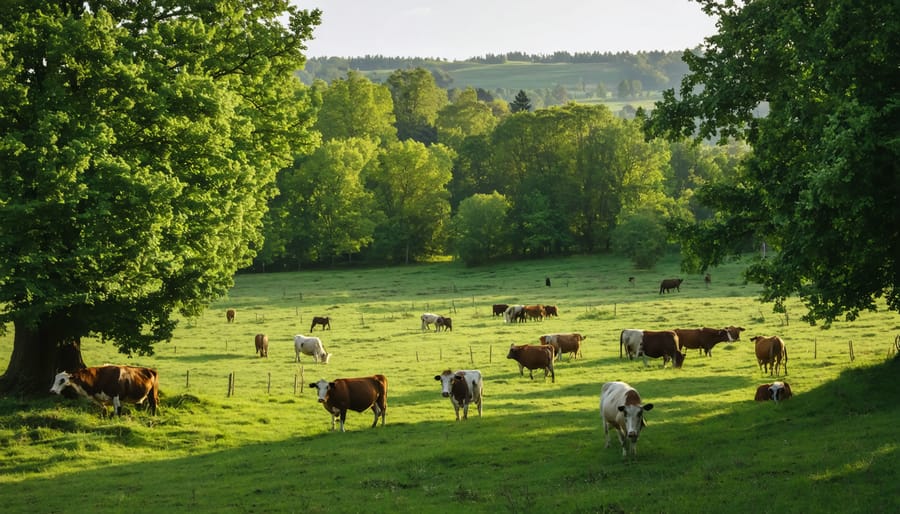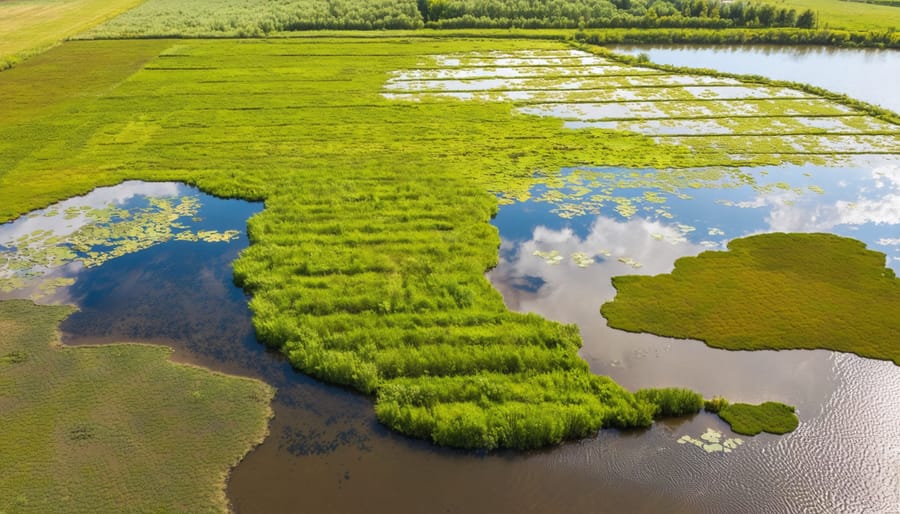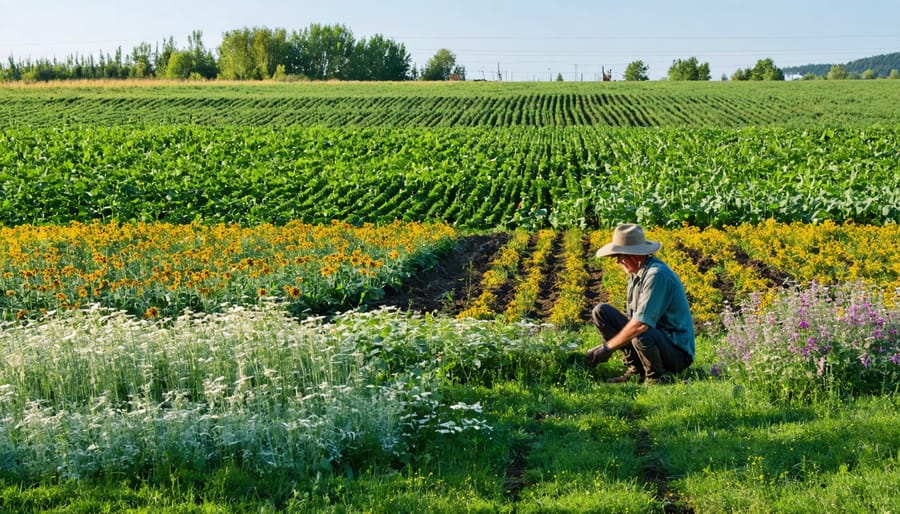Crush basalt or olivine rocks into a fine powder and spread it across your agricultural fields to accelerate natural weathering processes – one of the most promising natural climate solutions available to Canadian farmers. This centuries-old practice is gaining new relevance as research shows it can sequester up to 4 tonnes of CO2 per hectare annually while enriching soil with essential minerals and micronutrients.
Enhanced rock weathering works by mimicking and accelerating Earth’s natural carbon-capture process. When crushed rock particles interact with rain and soil microbes, they trap atmospheric CO2 while releasing nutrients that boost crop yields and soil health. For Alberta farmers facing increasingly uncertain growing conditions, this dual benefit of carbon sequestration and improved soil fertility offers a practical path toward more resilient and sustainable agriculture.
Recent field trials across Alberta’s diverse agricultural regions demonstrate that enhanced rock weathering can increase yields by 10-20% while reducing fertilizer needs. With proper application methods and locally-sourced materials, this ancient technique is evolving into a cutting-edge tool for modern farming challenges.
The Science Behind Enhanced Rock Weathering
Why Basalt is the Rock Star of Carbon Sequestration
When it comes to carbon sequestration methods, basalt stands out as nature’s superstar. This dark, volcanic rock contains high levels of calcium and magnesium, making it exceptionally effective at capturing CO2. What sets basalt apart is its rapid weathering rate compared to other rocks, breaking down quickly when exposed to water and air.
For Alberta farmers, basalt’s accessibility is a major advantage – it’s abundant in Western Canada and can be sourced from local quarries. The rock’s mineral composition mirrors many essential plant nutrients, including phosphorus, potassium, and iron, effectively serving double duty as both a carbon capture tool and a natural fertilizer.
Basalt’s fine-grained structure means it can be easily crushed into a powder that spreads evenly across fields. When mixed with soil, these particles create thousands of tiny surfaces where weathering can occur, maximizing its carbon-capturing potential while improving soil structure and water retention. This combination of properties makes basalt particularly well-suited for our prairie farming conditions.
The Chemical Process Made Simple
Think of enhanced rock weathering like nature’s own composting process, but sped up. When we spread crushed rock on farmland, it starts a simple but powerful chemical reaction. As rain falls on these rock particles, it creates a slightly acidic solution that gradually breaks down the minerals – just like sugar dissolving in your morning coffee.
The rock minerals, especially calcium and silicates, react with carbon dioxide from the air and water from rain. This process transforms atmospheric CO2 into bicarbonate minerals that can be stored safely in the soil or eventually make their way to the ocean. Meanwhile, these reactions release valuable nutrients that your crops can use, similar to how traditional fertilizers work.
For Alberta farmers, this process works particularly well with our frequent rainfall patterns and slightly acidic soils. The freeze-thaw cycles we experience actually help break down the rock material faster, making the nutrients more available to crops throughout the growing season. It’s like getting a two-for-one deal: you’re helping fight climate change while improving your soil’s fertility naturally.
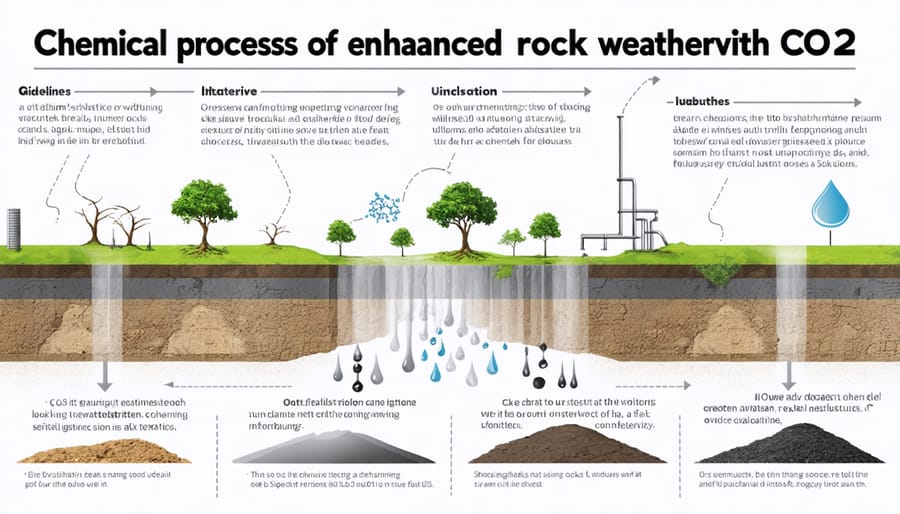
Practical Implementation on Alberta Farms
Sourcing and Applying Basalt
In Alberta, we’re fortunate to have several quarries and aggregate suppliers that produce high-quality basalt suitable for enhanced rock weathering. The Rocky Mountain region provides accessible sources, with major suppliers located near Calgary and Edmonton. When sourcing basalt, look for material that’s finely ground to 1-2mm particle size for optimal results.
Local suppliers typically offer both bulk delivery and bagged options. For larger operations, bulk delivery is most cost-effective, while smaller farms might prefer the convenience of 1-tonne bags. Always request a mineral composition analysis from your supplier to ensure the material meets agricultural standards.
Application methods vary depending on your farm’s size and equipment. For most Alberta farms, existing spreading equipment works well – the same machinery used for lime application can handle basalt. The recommended application rate is 10-40 tonnes per hectare, depending on your soil type and pH levels.
Best practices include applying basalt in early spring or fall when soil moisture levels are optimal. Spread the material evenly across your fields and incorporate it into the top 15-20cm of soil during regular tillage operations. For no-till operations, surface application before predicted rainfall works effectively.
Remember to wear appropriate dust protection during application, as fine rock particles can become airborne. Many local agricultural contractors now offer specialized spreading services if you prefer to outsource this task.

Equipment and Timing Considerations
Enhanced rock weathering can be implemented using standard farm equipment, making it accessible for most operations. The crushed rock material can be spread using conventional lime spreaders or fertilizer broadcasters, equipment many Alberta farmers already own. For larger operations, commercial spreaders capable of handling 10-20 tonnes per hour are recommended.
Timing is crucial for optimal results. Early spring application, just before seeding, allows the rock minerals to integrate with the soil during spring moisture. Fall application after harvest is another excellent option, giving the material time to weather over winter. For best results, application should coincide with soil temperatures above 10°C and adequate soil moisture levels.
Consider spreading the crushed rock material on calm days to minimize dust and ensure even distribution. Most farmers report success with application rates between 10-40 tonnes per hectare, depending on soil conditions and crop requirements. The spreading equipment should be calibrated properly to achieve uniform coverage, and protective gear should be worn during application to prevent dust inhalation.
Keep detailed records of application timing and weather conditions to help optimize future applications and track results over multiple growing seasons.
Cost Analysis and ROI
The initial investment for enhanced rock weathering typically ranges from $50 to $150 per hectare, depending on rock type and application method. While this may seem substantial, many Alberta farmers report breaking even within 2-3 growing seasons through improved crop yields and soil quality. Current carbon investment opportunities can offset up to 30% of implementation costs through provincial and federal programs.
Key cost factors include:
– Rock material: $30-80/tonne
– Transportation: $15-25/tonne
– Application equipment: $2,000-5,000 (one-time cost)
– Labor: $10-20/hectare
Available subsidies and incentives:
– Alberta’s Carbon Credit System
– Federal Agricultural Clean Technology Program
– Soil Conservation Credits
– Environmental Farm Plan grants
The ROI calculation should consider both direct benefits (increased yield, reduced fertilizer needs) and indirect benefits (improved drought resistance, soil structure). Most participating Alberta farms report a 15-25% increase in crop value within the first two years, with continuing improvements in subsequent seasons.
Additional Benefits for Your Soil
Soil Health Improvements
Enhanced rock weathering significantly improves soil health through multiple pathways, leading to substantial soil productivity improvements that benefit Alberta farmers. When crushed silicate rocks are applied to agricultural land, they enhance soil structure by increasing the formation of stable soil aggregates, which improves water retention and reduces erosion risks during our intense prairie storms.
The process naturally increases the soil’s cation exchange capacity (CEC), allowing it to better hold onto essential nutrients that crops need. For example, farmers in the Red Deer region have reported improved nutrient retention in their sandy soils after just one season of crushed basalt application. The weathering process also gradually releases vital minerals like calcium, magnesium, and potassium, creating a slow-release fertilizer effect that can last several growing seasons.
Perhaps most importantly for our prairie soils, enhanced rock weathering helps stabilize soil pH levels. This is particularly valuable in areas where conventional farming practices have led to soil acidification. The steady release of bases from the rock material acts as a natural buffer, maintaining optimal pH ranges for crop growth and beneficial soil microorganism activity.
Local soil testing has shown that fields treated with crushed silicate rocks typically show increased organic matter content within 2-3 years, creating a more resilient soil ecosystem that better supports crop production while improving drought resistance.
Crop Yield Enhancement
Recent field trials across Alberta and Saskatchewan have demonstrated impressive yield increases when enhanced rock weathering practices were implemented. In a three-year study conducted by the University of Alberta, wheat farmers reported average yield increases of 8-12% after applying crushed basalt at rates of 10-15 tonnes per hectare.
Dave Thompson, a third-generation farmer near Red Deer, participated in these trials and saw his canola yields increase by 15% in the second year of application. “The soil structure improved significantly, and we noticed better water retention during dry spells,” Thompson reports.
The trials also showed notable improvements in soil pH levels, particularly beneficial for acidic soils common in central Alberta. Farms implementing enhanced rock weathering reported reduced need for lime application, resulting in cost savings of approximately $75-100 per hectare annually.
Beyond yield improvements, participating farms documented enhanced crop resilience during extreme weather events. During the 2022 drought, fields treated with crushed rock maintained yields about 10% higher than untreated control plots.
Soil testing from these trials revealed increased availability of essential nutrients, particularly potassium and magnesium, reducing the need for conventional fertilizers. The cumulative data suggests that initial investment in rock application can be recovered within 2-3 growing seasons through improved yields and reduced input costs.
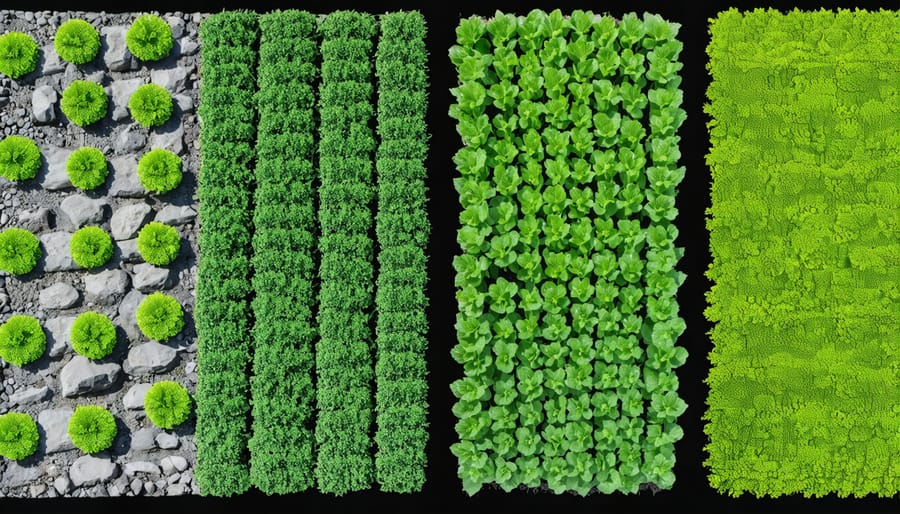
Real Results: Alberta Success Stories
Prairie Grain Farm Case Study
In 2021, the Smith family farm in Red Deer County, Alberta, partnered with the Prairie Soil Enhancement Initiative to implement enhanced rock weathering across 400 hectares of cropland. The project involved spreading finely crushed basalt at a rate of 30 tonnes per hectare, focusing primarily on their canola and wheat fields.
Initial soil tests showed pH levels of 5.8, indicating slightly acidic conditions. After 18 months of implementation, follow-up testing revealed significant improvements. Soil pH increased to 6.4, moving closer to optimal growing conditions. The basalt application also boosted available silicon, calcium, and magnesium in the soil.
The Smiths reported a 12% increase in crop yield during the second growing season, with particularly notable improvements in their canola production. Soil structure showed enhanced water retention capabilities, helping crops better withstand dry spells common to the region. The farm’s carbon dioxide sequestration was estimated at 4 tonnes per hectare annually.
Cost analysis revealed an initial investment of $175 per hectare, including material and spreading costs. The yield improvements and carbon credits generated through the program helped offset these expenses within two growing seasons. The success of this implementation has inspired fifteen neighbouring farms to adopt similar practices, creating a growing community of enhanced rock weathering practitioners in central Alberta.
Mixed Farming Operation Results
At the Henderson Family Farm in central Alberta, the implementation of enhanced rock weathering across their diverse 800-hectare operation has yielded impressive results. Over a three-year period, their mixed farming system, which includes canola, wheat, and pulse crops, showed notable improvements in soil health and crop yields.
Sarah Henderson, a third-generation farmer, reports a 15% increase in canola yields and a 12% improvement in wheat production since incorporating basalt rock dust into their soil management program. Their pulse crops demonstrated enhanced nitrogen fixation capabilities, reducing the need for synthetic fertilizers by approximately 20%.
The farm’s soil testing revealed significant improvements in key minerals, particularly calcium and magnesium levels, while soil pH stabilized in the optimal range for crop growth. Carbon dioxide capture rates, monitored through soil sampling, indicated sequestration of roughly 8 tonnes of CO2 per hectare annually.
What’s particularly noteworthy is the farm’s success in integrating rock dust application with their existing conservation tillage practices. The Hendersons developed a modified spreader system that allows for efficient distribution during their regular field operations, minimizing additional labor costs and soil disturbance.
The operation also noticed improved drought resilience during the particularly dry season of 2021, with crops showing better stress tolerance compared to neighboring farms. This real-world example demonstrates how enhanced rock weathering can benefit diverse farming operations while contributing to climate-smart agriculture practices.
Enhanced rock weathering presents a promising opportunity for Alberta farmers to contribute to climate change mitigation while potentially improving soil health and crop yields. By incorporating crushed basalt or other suitable rocks into their existing farming practices, producers can participate in this innovative approach to carbon sequestration.
As we’ve explored throughout this article, the benefits extend beyond carbon capture to include improved soil pH management, enhanced mineral availability, and potential increases in crop resilience. The initial investment in crushed rock materials and spreading equipment can be offset by long-term soil improvements and potential carbon credit opportunities.
For farmers interested in implementing enhanced rock weathering, the next steps are straightforward. Start by conducting comprehensive soil testing to establish your baseline conditions. Connect with local agricultural extension offices or soil specialists who can provide guidance specific to your operation. Consider starting with a small trial area to understand how the practice works on your land before scaling up.
Remember that you’re not alone in this journey. A growing community of Alberta farmers is already experimenting with enhanced rock weathering, and their experiences provide valuable insights. Stay connected with local agricultural organizations and research institutions for the latest developments and best practices.
For additional support, reach out to your regional agricultural fieldman or join local farming forums where you can share experiences and learn from others implementing similar practices. Together, we can build a more sustainable and resilient agricultural future for Alberta.


